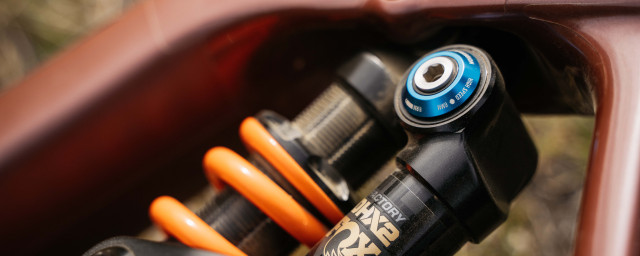
- Fast and good handling
- Adjustable geometry isn't a gimmick
- Comfortable on rough terrain
- There are better specced bikes for the money
- Slightly hard front-end
- Distinctive looks
The Rondo Ruut CF2 is a fast and surefooted carbon fibre gravel bike with a neat trick up its sleeve - adjustable geometry - providing a small level of ride attitude tuning that helps it stand out in an increasingly crowded market. I’d like to see wider tyres fitted as standard though, but that aside there's a lot to like here.
- The best gravel and adventure bikes you can buy for under £2,000
- Buyer's guide to gravel & adventure bikes - everything you need to know
- Five things that weren't cool - until gravel happened
Adjustable geometry is a relatively common feature on full suspension mountain bikes but rarely seen on drop bar bikes. So when Rondo introduced Twin Tip a few years ago, its name for adjustable fork axle positioning, we were intrigued. Pat got his head around it with the cheaper Rondo HVRT AL last year and was impressed. In case you missed it, here’s a quick tech reminder.
A small chip in the fork dropout can be flipped between a HI and LO position, altering the head and seat angle by 0.5 degrees, adjusting trail by 13mm and raising the front-end by 10mm. The idea is that the change provides two different sorts of handling attitude: HI gives a lower racer stance, LO provides a more relaxed riding position.
The change takes a few minutes with a 3mm Allen key and swapping the flip chips is a cinch, but fiddling with the brake adapter slows down the change It’s not something you’d want to do on the side of the trail, but set in advance.
Let’s put some numbers on those changes with the size large test bike we have here:
- In Hi the Ruut CF2 has a 397mm reach, 572mm stack, 571mm effective top tube, 74mm bottom bracket drop, 55mm fork offset, 56mm trail and 72-degree head angle.
- In Lo the numbers change to 391mm, 587mm, 569mm, 70mm, 45mm, 70mm and 71.5-degree respectively.
The difference is quite small, but you can detect it nonetheless. The biggest impact is due to the change in trail. Trail is the horizontal distance that the centre of the front tyre contact patch trails behind the steering axis. The longer trail in the Lo setting creates more stability and slower steering, while the shorter trail of the Hi mode produces a more agile bike.
Which setting is best for you is down to personal preference. I can see the former being good for gravel races and the latter for bike packing adventures where the demands are quite different. It’s worth experimenting with to see which setting suits your riding style and preference.
Regardless of the setting you opt for, after a short while you do adapt, and can focus on the very stable handling over any sort of terrain that the Ruut offers. It’s on the relaxed and planted side of the handlebar spectrum compared to some other gravel bikes, but it’s easy to rotate around tight corners and thread through tree-lined singletrack and dodge squirrels.
It’s fast too On the road, the 35mm tyres purr along very nicely. The frame and fork reveal a high level of stiffness for cranking up climbs or sprinting out of the saddle. It’s clear the Ruut CF2 has been designed for covering ground at speed and it’s one that doesn’t let up on the road. That’s handy if you have no choice but to include roads on your adventure routes.
Get off-road and it's right at home. Comfort is impressive in the rough and shows the advantage of a carbon frame. Riding along a bumpy grass track or loose gravel surface reveals very good comfort at the saddle. It’s not so much that you can feel flex at the saddle, more that the impacts aren’t finding their way through to your butt as easily as they can on harder riding gravel bikes.
There is however a bit of unbalance between comfort from the frame versus the stiff fork. That beefy fork is great for providing sharp handling and taking all the big impacts from rough terrain, but it does deliver just a touch too much feedback through the bars for my liking. I am being really picky here, but that is my job! Another wrap of bar tape might be enough to take the edge off, as might upgrading to a carbon handlebar.
Frame design and equipment
If we’re being kind, the carbon fibre frame has a unique appearance. If we're being unfair, it's downright ugly. I'll let you decide. The kinked top tube, along with a scalloped seat tube and looped dropouts, is intended to provide targeted flex to aid comfort on rough trails. As well as specific tube shaping, the carbon layup has been modified to eke out as much flex as possible. It works too, as my comments about the comfort a few paragraphs earlier reveal.
There’s more interesting tube shaping evident in the down tube and top tube, a sort of squashed oval with sharp edges. The drive-side chainstay meanwhile has been dropped to increase tyre clearance and keep the chainstays short. Talking of which, there’s space for up 700x40c or 650Bx2.1" tyres - the test bike came with the former. There are 12mm thru-axles clamping the wheels into place and all cables and hoses are internally routed, with 1x and 2x drivetrains supported.
The Ruut CF2 costs £2,700 and is the cheapest of three carbon models in this range. There’s also the £3,300 CF1 and the CF0 for £5,299 if you’re feeling flush. Same frame, posher components.
The pictured test bike is equipped with an SRAM Rival 1x groupset, pairing a 40t chainring to a 10-42t cassette which provides a good spread of ratios for grinding up steep climbs and through boggy bridleways.
Tyres go a long way to defining the sort of riding a gravel bike is intended for, and the popular Gravel King SK from Panaracer is a smart choice. The width is a bit measly at just 35mm though, I’d have preferred a wider tyre to make use of the full clearance the frame and fork provide.
Lack of width aside, the Gravelking tyre is a good choice for everything from country lanes to tackling singletrack, gravel roads and, at a stretch, muddy tracks. It's a firm fave here at off.road.cc.
The tyres are mounted to Rondo’s own wheels, combining aluminium hubs with tubeless-ready aluminium rims with rather fetching graphics that you’ll either love or fate. The rubber bands looped around each hub is a throwback to the 90s, intended to keep the hubs sparkling.
Finishing kit is a Fabric Scoop Flat saddle, Rondo’s own flared handlebar and smart colour-matched stem and an Easton EA50 seatpost. It’s all decent and respectable kit that caused no issues during testing.
Rivals
A Specialized Diverge Sport costs £2,750 with a carbon frame and the unique Future Shock front suspension and a Shimano 105 groupset. But you can get SRAM Force on a carbon fibre Canyon Grail CF SL 8.0 SL for £2,549, though you do have to contend with the double-decker handlebars.
Conclusion
The Ruut CF2 provides very good handling manners on and off the road, with the fairly unique proposition of adjustable geometry. The difference may be small, but in a genre that is hard to define and categorise due to so many different interpretations, it’s a nice feature to have. Whether it’s enough to make you rush out and buy it for that alone is another matter.
In a market where bikes are increasingly looking the same, the Ruut CF2 has the honour of standing out, with that funky top tube and wheel rim graphics. And of course the adjustable geometry. It’s reasonable value for money too but it won’t be the cheapest route to a carbon frame with an SRAM Rival groupset.
Oh, if you’re wondering, Ruut is pronounced root [Route maybe? Ed]. So now you know.























Add comment